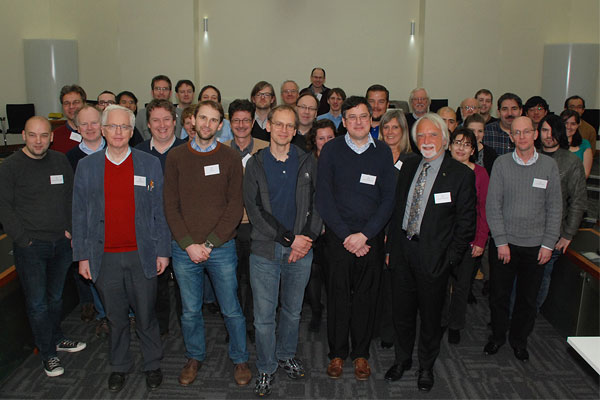Future Muon Sources – workshop welcomes international delegates
 Pictured above with the delegates from the Future Muon Sources workshop are (front row l-r): Professor Roger Barlow, Dr Jamie Peck, Dr Stephen Cottrell, Professor Rob Edgecock and Professor Bob Cywinski.
Pictured above with the delegates from the Future Muon Sources workshop are (front row l-r): Professor Roger Barlow, Dr Jamie Peck, Dr Stephen Cottrell, Professor Rob Edgecock and Professor Bob Cywinski.
Fri, 30 Jan 2015 11:42:00 GMT
STFC and the University combine for the international workshop entitled Future Muon Sources
MUON beams are a powerful research tool for scientists probing the properties of materials and are vital to the work of many physicists, chemists and biologists around the world. The continuing development of higher intensity beams is therefore of great importance and this subject was the focus of a recent international workshop at the University of Huddersfield.
Entitled Future Muon Sources, the two-day event included more than 20 presentations with discussion, involving scientists from countries including the UK, Switzerland, Italy, India, USA and Japan. The participants represented a mix of universities – including members of the University of Huddersfield’s International Institute for Accelerator Applications (IIAA) – and major research institutes, including the UK’s Science and Technology Facilities Council (STFC), which operates the ISIS neutron and muon source, the Paul Scherrer Institute (PSI) and the Japan Proton Accelerator Research Complex (J-PARC) which operate similar facilities in Switzerland and Japan.
Organisers of the conference included the University of Huddersfield’s Professor Rob Edgecock, and Dr Jamie Peck and Dr Stephen Cottrell, both from the STFC’s Rutherford Appleton Laboratory. Dr Peck explained that in addition to the presentations and chaired discussions, the event brought together two groups of people, accelerator designers and accelerator users, who rarely get to discuss how they can work together. It proved to be very successful as a catalyst for new ideas that should lead to future collaborations, said Dr Peck.
The workshop was the first of its kind, taking place under the aegis of two projects funded by EU framework programme 7. They are EuCARD-2 – which co-ordinates research and development on particle accelerators – and NMI3, a consortium that aims to co-ordinate Europe’s neutron scattering and muon spectroscopy research activities. NMI3 includes a task looking at future muon sources, stimulating this joint workshop.
 Presentations and workshops
Presentations and workshops
The Future Muon Sources workshop was opened by physicist Professor Bob Cywinski (pictured left), who is Dean of the University of Huddersfield’s Graduate School and a member of the IIAA. He has been Chairman of the European Neutron Scattering Association and President of the International Society for Muon Spectroscopy. His presentation provided an overview of existing muon sources and described how future sources could be tailored to meet the demands of users. There is a need to build a strong science case, emphasising the roles that muons can play in the “Grand Challenges” facing science, concluded Professor Cywinski.
The workshop included sessions about muon production and accelerator technologies; specialised beams; research using muons; and an update from the muon facilities. A final session took the meeting beyond the laboratory, hearing about novel applications of muons in areas including carbon capture and security.
The concluding session of the workshop was chaired by the University of Huddersfield’s Professor Rob Edgecock, who also holds a post with the STFC’s Accelerator Science and Technology Centre. His presentation included a round-up of further workshops to be held at locations that include the Geneva HQ of CERN, the European Organisation for Nuclear Research. The content of the presentations at the Future Muon Sources workshop have been made available via the CERN website.







